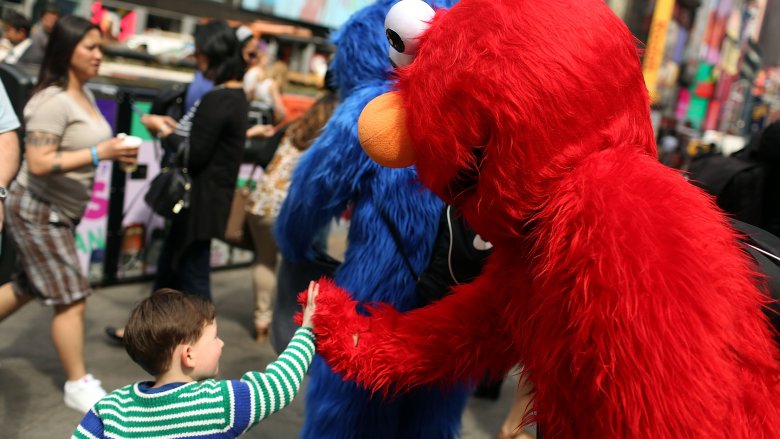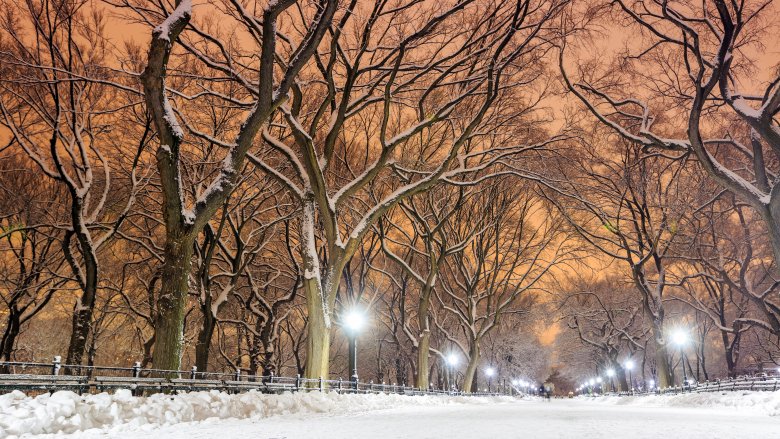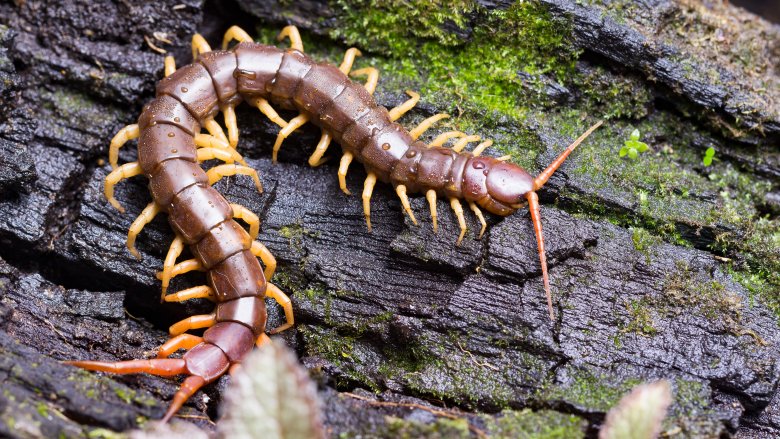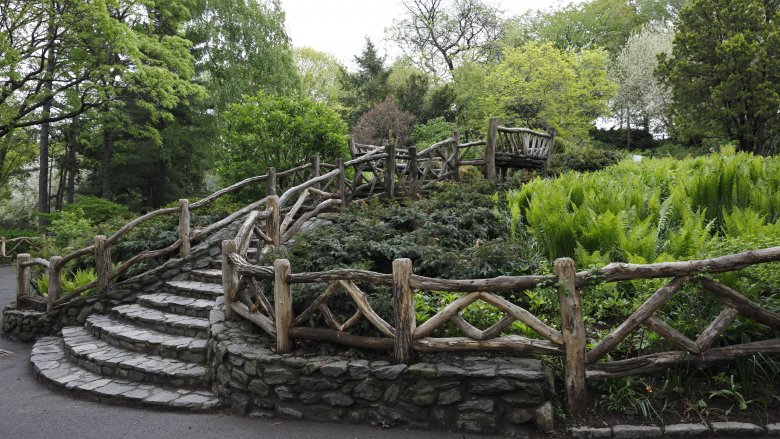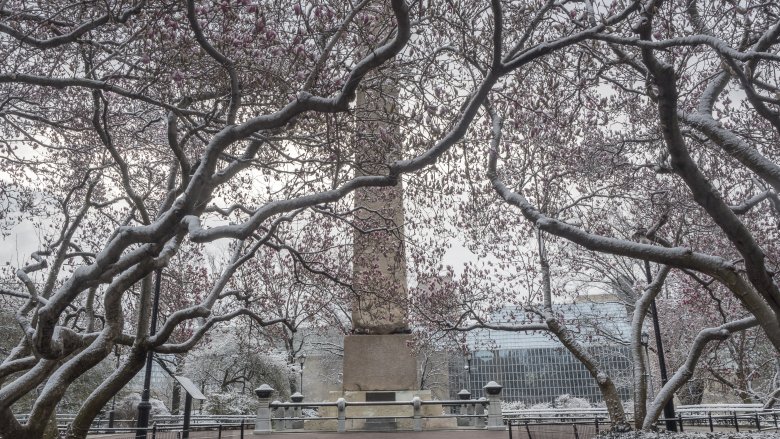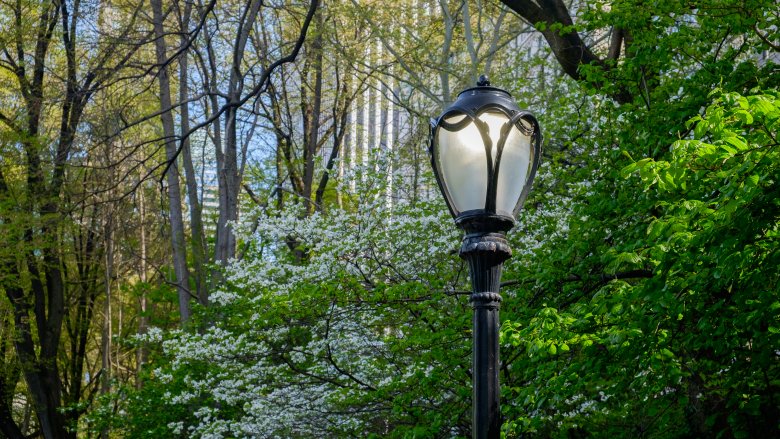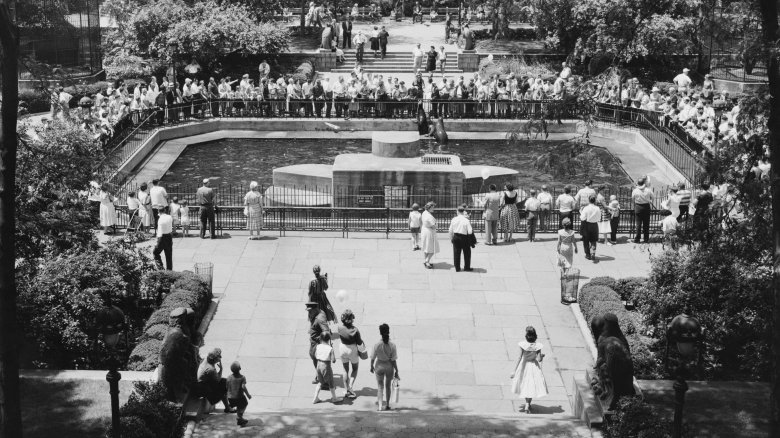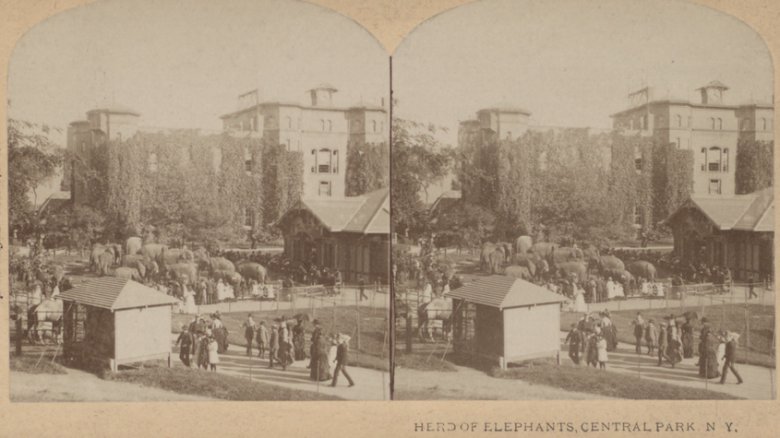Weird Secrets Of Central Park
Whether you live local enough to jog there every day or if you've just seen one of the hundreds of movies it's starred in, you know Central Park. It's the green heart of the Big Apple, and people are there 24/7. With that much going on, it might seem impossible to hide some secrets within all that lush greenery, but it totally does. Let's pull back the curtain and go hiking. Digitally, of course. Outdoors has bugs.
There's a heartbreaking memorial Christmas tree
Christmas can be the pits, especially if the furry friend who used to help you put up the tree (then knock it down) is no longer there. You're not alone in feeling sad. Untapped Cities says when they got wind of a memorial Christmas tree to beloved pets somewhere in Central Park, they had a hard time finding it at first. The group behind the tree doesn't reveal much information about it — including the location — but they've been doing it since at least 2010.
Untapped Cities did eventually find the tree, decorated with ornaments, ribbons, and loving tributes to pets no longer around to sleep under the tree and lick the bowls of Christmas cookie dough. Ornaments are removed post-Christmas and returned the next year, and every year, there are a few more. They say you're not likely to stumble across the tree unless you're looking for it, and they still won't reveal the exact location. Some things are just meant to be a little more private.
Elmo's meltdown
You can't go to Central Park without running into the people dressed in costumes, getting their picture taken with your little tyke for some cash. There's nothing wrong with that, but when The New York Times reported on a Central Park Elmo's anti-Semitic meltdown and escort to the Metropolitan Hospital Center for a psychiatric evaluation, they shared a terrifying secret with the world: There are zero regulations in place about who can put on a furry costume and approach your kids.
This Elmo's rant was just the nasty scum on the surface of a nastier septic tank of funk. When he was being questioned, he told authorities his name was actually Adam Sandler (not the one you're thinking of), and he lived in Cambodia until getting in trouble for running an adult site called "Welcome to the Rape Camp." The site got all kinds of attention from the Cambodian police because obviously.
Since you apparently can't be arrested for just having a terrible fetish, he was deported. After that, he got work at the office for the Girl Scouts of the USA in New York, through a temp agency that apparently needs better background checks. From there, it was on with the Elmo costume. Sandler admitted he'd had somewhere around 15 similar outbursts and rants, but he still stayed in Central Park. No reputable company (including Sesame Street) authorizes the actors, no one regulates them, and they're still giving hugs to kids.
An entire community was destroyed to build the park
Eminent domain is one of those laws you learned about in middle school, and it's essentially the government's right to take your land if it really wants to. That's exactly what happened in New York City in the 1850s, when 264 people were evicted from the community they called Seneca Village. They also called it things like "home" and "their own," but that didn't matter. They were still kicked off their land and it was incorporated into the park.
The families living there owned the land themselves. The little community had a school and three churches, and homes belonging to families like the Gallaghers, the Allens, and the McCollins. That last name might give you a hint as to who was evicted: The residents were two-thirds black and one-third Irish. City Metric even calls Seneca Village "Manhattan's first prominent community of African American property owners," but by the 1990s, the village's mere existence was regarded as something along the lines of an urban myth. It was very real, and it's since been excavated.
Today, Central Park recognizes that Seneca Village once comprised the parkland between 82nd and 89th Streets and Seventh and Eighth Avenue. The heartbreaking story of those evictions is slowly being told, but Seneca Village was never reestablished anywhere else. Those families simply scattered to the winds.
There are completely undiscovered species living there
You expect new species to be discovered in, say, Sumatra. (Mostly because you're not even sure where that is.) But Central Park? It turns out there are species we're still discovering there, too.
In 2002, CBC News announced the discovery of a tiny, 12-millimeter centipede living in Central Park. It was named Nannarrup hoffmani, and researchers say it's not just a new species, it's a whole new genus that might contain still more species. They're not sure just what's going on here, but they suspect the little guy's ancestors hitched a ride to New York from somewhere in Asia, then set up a new home.
It also gets weirder (and more disgusting). In 2017, the Smithsonian announced a fly discovered in 2007 had been mistaken for a fly we already knew about; it was actually a whole new species. Researchers found it in Central Park near Harlem Meer, a lake with the perfect environment for a fly that can only breed in duck poop. Talk about a specialized fetish.
Shakespeare's Garden and the Whisper Bench
Even if you've been to Shakespeare's Garden, you might not realize how cool it really is. It was rechristened in Shakespeare's honor in 1916, and Central Park says the only plants included in the gardens are ones mentioned in his works. That makes for a batch of plants that sound like they're right out of an Elder Scrolls game, including things like wormwood, columbine, and flax.
While you're there practicing your alchemy (that's frowned upon, don't pick the flowers), you can also visit a very cool stone bench that's hiding a neat secret. Gothamist says it's similar to the more famous Whisper Wall in Grand Central, as you and a friend can sit at opposite ends of the bench and whisper to each other. The sound travels along the 20-foot granite curve, and you'll be able to hear each other as clear as day. Science is pretty neat.
The markers of city plans that once were
When John Randel Jr. was asked to lay out gridwork for this new place called New York City, there were no plans to include Central Park. The entire area was just a network of more streets, and when construction crews started putting granite markers at the intersections where the streets they were building would cross, they laid them across what's now Central Park, too. According to the New Yorker, the first granite marker was only excavated in 2014, and at the time, it was the only one anyone had ever found. The markers were 3 feet tall and 9 inches square, and there were once hundreds of them mapping out the new city. Most have been destroyed, but three more have been found under Central Park, indicating where streets would have been.
That's a pretty cool piece of history, and there's another little bit in Central Park, too. In areas where the marble markers couldn't be installed, surveyors used iron bolts instead. There's one in Central Park, and Curbed New York says it's a secret. It's one of a few left in the city, and it's somewhere in the southeastern corner of the park. Why is it so secret? Who knows? Maybe the world needs more cool secrets like this.
Central Park's shockingly ancient obelisk
Cleopatra's Needle has been standing in Central Park since 1881, and that sounds like a long time. It is — for the U.S. — and chances are pretty good the countless people who have walked past it have no idea they're walking past something that was standing at the same time the original draft of the Bible was being written.
Sullivan Engineering says it was given to the city as a gift, a 220-ton present from Ismaa'il Pasha, Khedive of Egypt. The obelisk's name is a little deceiving, as it predates the legendary Cleopatra by more than 1,000 years. The monument was built by Thutmose III after he became king in 1479 B.C., according to Encyclopedia Britannica.
Scouting NY gives us some fascinating tidbits of history. The stone was quarried from near the Nile River, and the hieroglyphics covering the monument were added over hundreds of years. Most tell the story of the military victories of Ramesses II the Great. Some of the damage was done by ancient Persians, and crabs were added by the ancient Romans around 13 B.C. to stabilize the column. (The originals are in The Met.) Since it's still tough to imagine the scale of time the 3,400-year-old obelisk has seen, look at it this way. The Statue of Liberty was installed in New York at roughly the same time — 1886 — and won't be 3,400 years old until the year 5286.
There's a secret code on every lamppost
Central Park is huge. According to Spoiled NYC, it's 2.5 miles long and half a mile wide. For perspective, it's almost as long as Venice, and it's larger than Monaco. In other words, it's definitely big enough to get seriously lost in.
Fortunately, all you need to do to figure out exactly where you are is find a lamppost. According to The Telegraph, there's an olde-timey map system built into Central Park, and you can find it in the numerical codes on each of the lampposts. The first two numbers tell you what street is nearest. If the last number is odd, you're on the west side of the park. If it's even, you're on the east side. Pretty nifty, right?
Everyone forgot where those iconic eagles came from
Central Park is full of iconic monuments, but let's talk about those eagles. Today, they stand over the Sea Lion Pool, and they look like they belong there. Possibly hunting, possibly reminding sea lions of the virtues of behaving.
They didn't always belong there, though, and according to NYC Parks, there was a long spell where no one knew where they had actually come from. They were just sort of always there, and it wasn't until recently that researchers found photos of them in their original location, buried in photographs in the Parks Department Photo Archive. It turns out they were rescued from an overpass in Bay Ridge, Brooklyn, where they had perched from 1912 to 1941. When the overpass was demolished, someone ordered them to be salvaged and installed in the Central Park Zoo. There's still a bit of a mystery here, as the only evidence of the move we have is a single journal entry that honestly doesn't clear matters up in the slightest. We have no idea who saved the eagles or ordered the move, but they helped create a landmark.
The Arsenal was the original zoo
It's tough to imagine, but Central Park Zoo wasn't always supposed to be. It only became a thing after a strange, uncomfortable start.
The zoo's first animals were kept in cages in the basement of The Arsenal, according to Untapped Cities, and "Hey, it was 1859," shouldn't be an excuse for keeping any animal in those conditions. If you're wondering where those first animals came from, some were unwanted pets dropped off in the park. People had different ideas about pets then, and Central Park says the earliest residents included white swans and a bear cub. They were only moved when the smell became too bad for the people working in other parts of the building, which is pretty terrible.
And it seems people are still dropping off the occasional animal. In 2009, ABC News reported reptile wranglers were called in to catch a crocodile that was wandering Harlem Meer, seeming to exist only to prove that occasionally, urban legends have a grain of truth to them after all.


